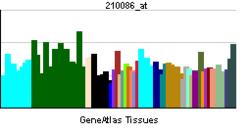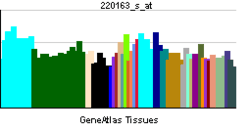HR (gene)
| HR | |||||||||||||||||
|---|---|---|---|---|---|---|---|---|---|---|---|---|---|---|---|---|---|
| Identifiers | |||||||||||||||||
| Aliases | HR, ALUNC, AU, HSA277165, HYPT4, MUHH, MUHH1, hair growth associated | ||||||||||||||||
| External IDs | MGI: 96223 HomoloGene: 3774 GeneCards: HR | ||||||||||||||||
| Genetically Related Diseases | |||||||||||||||||
| obesity[1] | |||||||||||||||||
| |||||||||||||||||
| RNA expression pattern | |||||||||||||||||
  | |||||||||||||||||
| More reference expression data | |||||||||||||||||
| Orthologs | |||||||||||||||||
| Species | Human | Mouse | |||||||||||||||
| Entrez | |||||||||||||||||
| Ensembl | |||||||||||||||||
| UniProt | |||||||||||||||||
| RefSeq (mRNA) | |||||||||||||||||
| RefSeq (protein) | |||||||||||||||||
| Location (UCSC) | Chr 8: 22.11 – 22.13 Mb | Chr 14: 70.55 – 70.57 Mb | |||||||||||||||
| PubMed search | [2] | [3] | |||||||||||||||
| Wikidata | |||||||||||||||||
| View/Edit Human | View/Edit Mouse |
Protein hairless is a protein that in humans is encoded by the HR gene.[4][5][6]
This gene encodes a protein whose function has been linked to hair growth. A similar protein in rat functions as a transcriptional corepressor for thyroid hormone and interacts with histone deacetylases. Mutations in this gene have been documented in cases of autosomal recessive congenital alopecia and atrichia with papular lesions.[6]
See also
References
- ↑ "Diseases that are genetically associated with HR view/edit references on wikidata".
- ↑ "Human PubMed Reference:".
- ↑ "Mouse PubMed Reference:".
- ↑ Ahmad W, Zlotogorski A, Panteleyev AA, Lam H, Ahmad M, ul Haque MF, Abdallah HM, Dragan L, Christiano AM (Apr 1999). "Genomic organization of the human hairless gene (HR) and identification of a mutation underlying congenital atrichia in an Arab Palestinian family". Genomics. 56 (2): 141–8. doi:10.1006/geno.1998.5699. PMID 10051399.
- ↑ Nothen MM, Cichon S, Vogt IR, Hemmer S, Kruse R, Knapp M, Holler T, Faiyaz ul Haque M, Haque S, Propping P, Ahmad M, Rietschel M (Apr 1998). "A gene for universal congenital alopecia maps to chromosome 8p21-22". Am J Hum Genet. 62 (2): 386–90. doi:10.1086/301717. PMC 1376893
 . PMID 9463324.
. PMID 9463324. - 1 2 "Entrez Gene: HR hairless homolog (mouse)".
Further reading
- Ahmad M, Abbas H, Haque S (1993). "Alopecia universalis as a single abnormality in an inbred Pakistani kindred". Am. J. Med. Genet. 46 (4): 369–71. doi:10.1002/ajmg.1320460405. PMID 8357006.
- Ahmad W, Faiyaz ul Haque M, Brancolini V, et al. (1998). "Alopecia universalis associated with a mutation in the human hairless gene". Science. 279 (5351): 720–4. doi:10.1126/science.279.5351.720. PMID 9445480.
- Cichon S, Anker M, Vogt IR, et al. (1998). "Cloning, genomic organization, alternative transcripts and mutational analysis of the gene responsible for autosomal recessive universal congenital alopecia". Hum. Mol. Genet. 7 (11): 1671–9. doi:10.1093/hmg/7.11.1671. PMID 9736769.
- Ahmad W, Irvine AD, Lam H, et al. (1998). "A missense mutation in the zinc-finger domain of the human hairless gene underlies congenital atrichia in a family of Irish travellers". Am. J. Hum. Genet. 63 (4): 984–91. doi:10.1086/302069. PMC 1377501
 . PMID 9758627.
. PMID 9758627. - Sprecher E, Bergman R, Szargel R, et al. (1999). "Identification of a genetic defect in the hairless gene in atrichia with papular lesions: evidence for phenotypic heterogeneity among inherited atrichias". Am. J. Hum. Genet. 64 (5): 1323–9. doi:10.1086/302368. PMC 1377868
 . PMID 10205263.
. PMID 10205263. - Ahmad W, Nomura K, McGrath JA, et al. (1999). "A homozygous nonsense mutation in the zinc-finger domain of the human hairless gene underlies congenital atrichia". J. Invest. Dermatol. 113 (2): 281–3. doi:10.1046/j.1523-1747.1999.00686.x. PMID 10469319.
- Hillmer AM, Kruse R, Betz RC, et al. (2001). "Variant 1859G→A (Arg620Gln) of the "Hairless" Gene: Absence of Association with Papular Atrichia or Androgenetic Alopecia". Am. J. Hum. Genet. 69 (1): 235–7. doi:10.1086/321273. PMC 1226040
 . PMID 11410842.
. PMID 11410842. - Potter GB, Beaudoin GM, DeRenzo CL, et al. (2001). "The hairless gene mutated in congenital hair loss disorders encodes a novel nuclear receptor corepressor". Genes Dev. 15 (20): 2687–701. doi:10.1101/gad.916701. PMC 312820
 . PMID 11641275.
. PMID 11641275. - Dintilhac A, Bernués J (2002). "HMGB1 interacts with many apparently unrelated proteins by recognizing short amino acid sequences". J. Biol. Chem. 277 (9): 7021–8. doi:10.1074/jbc.M108417200. PMID 11748221.
- Hillmer AM, Kruse R, Macciardi F, et al. (2002). "The hairless gene in androgenetic alopecia: results of a systematic mutation screening and a family-based association approach". Br. J. Dermatol. 146 (4): 601–8. doi:10.1046/j.1365-2133.2002.04766.x. PMID 11966690.
- Henn W, Zlotogorski A, Lam H, et al. (2002). "Atrichia with papular lesions resulting from compound heterozygous mutations in the hairless gene: A lesson for differential diagnosis of alopecia universalis". J. Am. Acad. Dermatol. 47 (4): 519–23. doi:10.1067/mjd.2002.124609. PMID 12271294.
- Klein I, Bergman R, Indelman M, Sprecher E (2002). "A novel missense mutation affecting the human hairless thyroid receptor interacting domain 2 causes congenital atrichia". J. Invest. Dermatol. 119 (4): 920–2. doi:10.1046/j.1523-1747.2002.00268.x. PMID 12406339.
- Strausberg RL, Feingold EA, Grouse LH, et al. (2003). "Generation and initial analysis of more than 15,000 full-length human and mouse cDNA sequences". Proc. Natl. Acad. Sci. U.S.A. 99 (26): 16899–903. doi:10.1073/pnas.242603899. PMC 139241
 . PMID 12477932.
. PMID 12477932. - Fernández A, Silió L, Noguera JL, et al. (2004). "Linkage mapping of the porcine hairless gene (HR ) to chromosome 14". Anim. Genet. 34 (4): 317–8. doi:10.1046/j.1365-2052.2003.01032.x. PMID 12873232.
- Ota T, Suzuki Y, Nishikawa T, et al. (2004). "Complete sequencing and characterization of 21,243 full-length human cDNAs". Nat. Genet. 36 (1): 40–5. doi:10.1038/ng1285. PMID 14702039.
- Gerhard DS, Wagner L, Feingold EA, et al. (2004). "The Status, Quality, and Expansion of the NIH Full-Length cDNA Project: The Mammalian Gene Collection (MGC)". Genome Res. 14 (10B): 2121–7. doi:10.1101/gr.2596504. PMC 528928
 . PMID 15489334.
. PMID 15489334. - Xie Z, Chang S, Oda Y, Bikle DD (2006). "Hairless suppresses vitamin D receptor transactivation in human keratinocytes". Endocrinology. 147 (1): 314–23. doi:10.1210/en.2005-1111. PMID 16269453.
- Betz RC, Indelman M, Pforr J, et al. (2007). "Identification of mutations in the human hairless gene in two new families with congenital atrichia". Arch. Dermatol. Res. 299 (3): 157–61. doi:10.1007/s00403-007-0747-8. PMID 17372750.
External links
- HR protein, human at the US National Library of Medicine Medical Subject Headings (MeSH)
This article is issued from Wikipedia - version of the 5/31/2016. The text is available under the Creative Commons Attribution/Share Alike but additional terms may apply for the media files.